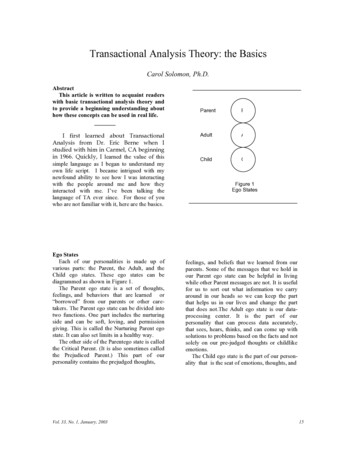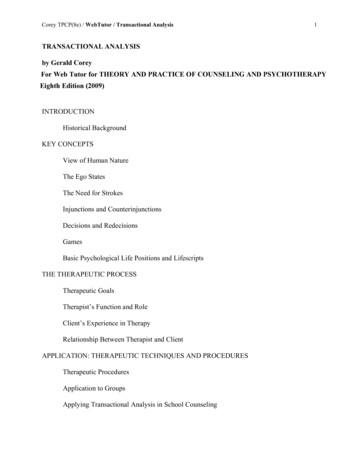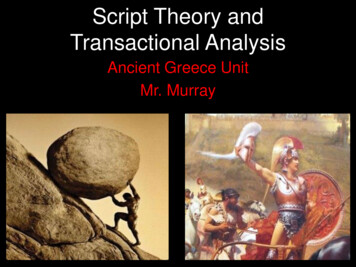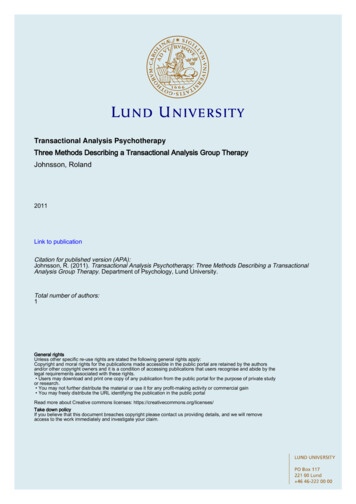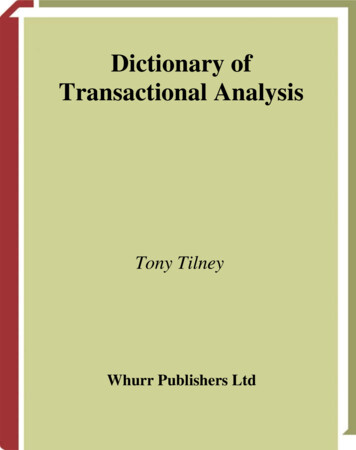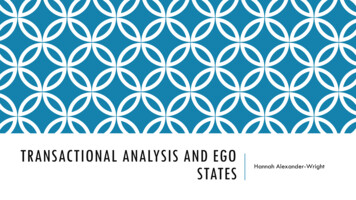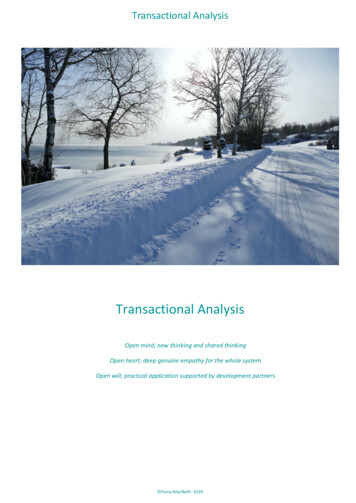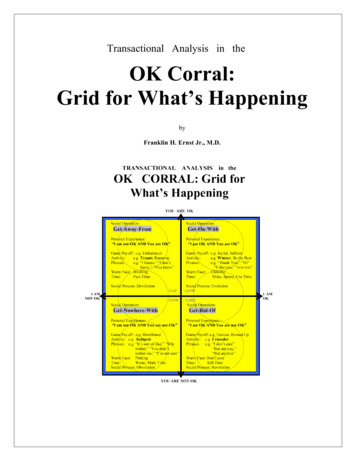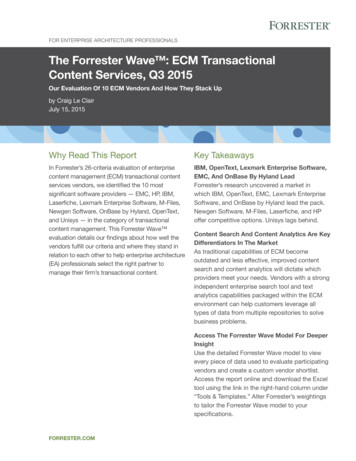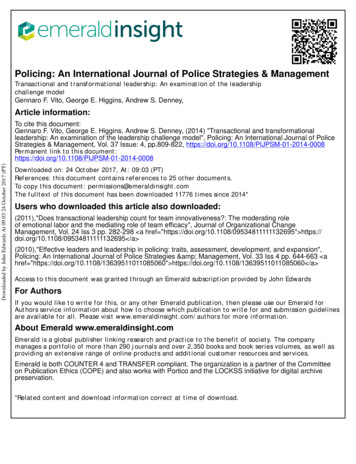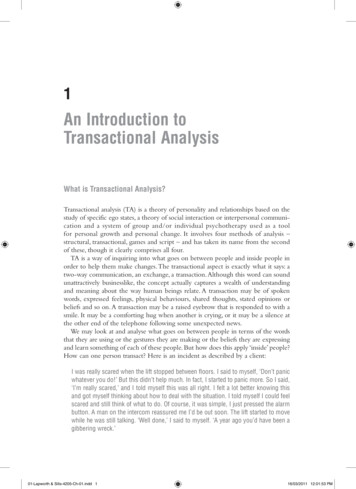
Transcription
1An Introduction toTransactional AnalysisWhat is Transactional Analysis?Transactional analysis (TA) is a theory of personality and relationships based on thestudy of specific ego states, a theory of social interaction or interpersonal communication and a system of group and/or individual psychotherapy used as a toolfor personal growth and personal change. It involves four methods of analysis –structural, transactional, games and script – and has taken its name from the secondof these, though it clearly comprises all four.TA is a way of inquiring into what goes on between people and inside people inorder to help them make changes. The transactional aspect is exactly what it says: atwo-way communication, an exchange, a transaction. Although this word can soundunattractively businesslike, the concept actually captures a wealth of understandingand meaning about the way human beings relate. A transaction may be of spokenwords, expressed feelings, physical behaviours, shared thoughts, stated opinions orbeliefs and so on. A transaction may be a raised eyebrow that is responded to with asmile. It may be a comforting hug when another is crying, or it may be a silence atthe other end of the telephone following some unexpected news.We may look at and analyse what goes on between people in terms of the wordsthat they are using or the gestures they are making or the beliefs they are expressingand learn something of each of these people. But how does this apply ‘inside’ people?How can one person transact? Here is an incident as described by a client:I was really scared when the lift stopped between floors. I said to myself, ‘Don’t panicwhatever you do!’ But this didn’t help much. In fact, I started to panic more. So I said,‘I’m really scared,’ and I told myself this was all right. I felt a lot better knowing thisand got myself thinking about how to deal with the situation. I told myself I could feelscared and still think of what to do. Of course, it was simple, I just pressed the alarmbutton. A man on the intercom reassured me I’d be out soon. The lift started to movewhile he was still talking. ‘Well done,’ I said to myself. ‘A year ago you’d have been agibbering wreck.’01-Lapworth & Sills-4205-Ch-01.indd 116/03/2011 12:01:53 PM
2An Introduction to Transactional AnalysisThis person is simply doing what we all do: he is talking to himself. Notice thatsometimes he refers to himself as ‘I’ and sometimes as ‘you’. In this way, though he isstill one person, he can hold an internal dialogue between different parts of himself.He is transacting internally.TA provides a model which defines these parts of oneself as different ego states.Whether it is thoughts, feelings or behaviours that are being exchanged externally orinternally – usually it is all three, whether we are aware of this or not – they will becoming from one of three types of ego state: the Parent, the Adult or the Child egostate. Early in this book, we will introduce the concept of ego states and will returnto the concept many times, as these ego states are the building-blocks of TA theory.This three-part model is both simple and profound. Unfortunately, like manygood ideas which have immediate appeal, the model is open to misuse. It can be seenin a rather simplistic way or used manipulatively for selfish and exploitative ends. EricBerne, the originator of the model, was astute enough to recognize this possibilityand in his catalogue of psychological ‘games people play’ included one called‘Transactional Analysis’, which is when people use TA to belittle themselves orothers. The simplicity and immediate usefulness of the TA model lies not only in thecolloquial language adopted to describe the various and often complicated concepts,but also in the ease of understanding and identification people tend to show inresponse to TA theory. It is not uncommon to hear people using ego state languageadeptly and creatively within minutes of its introduction. The profundity of the TAmodel lies in the depth and breadth of its psychological understanding and exploration. The list of contents of this book, including ego states, transactions, functionaland behavioural options, life script, and assessment and the process of change, indicates the range to which this three-part model may be applied. We hope this introductory book will show some of the depth and breadth of understanding that TAcan bring to many aspects of life, living, relating and communicating.Since its introduction and development by Eric Berne and others who will bementioned in this book, many people from varied professional backgrounds havebeen attracted to TA and found in it something useful and exciting. Clearly, they stilldo. What is it about TA that has attracted psychotherapists, counsellors, psychologists,doctors, coaches, social workers, nurses, teachers, children and others over the years?Here are some of the reasons we think TA is so popular: The basics of TA theory are expressed in simple, colloquial and easily understoodlanguage with words like ‘games’, ‘scripts’ and ‘strokes’ (a term that has now beenincluded in several English dictionaries as well as being commonly found in songsand TV programmes). Though there is now common reference to the ‘inner child’ both in popular and inmainstream psychology, counselling and psychotherapy literature, the term ‘Child’and the concept of part of oneself remaining phenomenologically alive as a childthroughout one’s adult life has been a central tenet in TA – a concept that is appealingand experientially validated and validating for many people. TA concepts are often shared with clients, so there is a talking with rather thantalking at clients. In this way the content and process of psychotherapy or coachingare demystified and developed into a shared endeavour.01-Lapworth & Sills-4205-Ch-01.indd 216/03/2011 12:01:53 PM
An Introduction to Transactional Analysis3 TA lays stress on personal responsibility for one’s experience and in so doing putsthe client in a central, proactive and therefore potentially powerful role in his or hersituation. In this respect, TA is referred to as a decisional model. If we are personally responsible for our own experience, we must be responsible for the choicesand decisions that we make about how we behave, how we feel, how we thinkand what we believe, even though many of these decisions may not be madein awareness, but at a pre- or non-conscious, somatic and emotional level. Even aschildren we made such decisions in response to the environments of home, schooland society. Clearly, some of these decisions were misinformed, misperceived,skewed by immaturity, but nonetheless the best we could manage in those earlycircumstances. Hope lies in the fact that as we become aware of the meaning wehave made of ourselves and the world, and the patterns we are enacting, new andreparative decisions can be made in the present to replace the now dysfunctionaland maladaptive decisions of the past.The appeal of TA to some may also be due to its embracing and integrating thethree main streams of psychology within its theoretical model: the psychoanalytic,the behavioural and the humanistic/existential. As mentioned earlier, Berne’s formative training was in psychoanalysis. TA theory owes much to the psychoanalyticthinking and experience with which Berne was familiar – to Freud, Klein, Fairbairn,Federn and Erikson, to name but a few – and to the concepts belonging to traditional psychoanalysis, ego psychology, social psychology and object relations, particularly intrapsychic phenomenological structures. For example, Parent, Adult andChild ego states are not the Superego, Ego and Id of psychoanalysis, but there is nodenying that they are derivatives. It is also clear that the Freudian concept of therepetition compulsion was developed by Berne into one of the central notions ofTA: that of the life script and the repetitive games and rackets that support it.An example of the inclusion of behavioural concepts is the emphasis given in TAto the effect of positive and negative reinforcement (operant conditioning) or ‘stroking’ as an important element of script formation. Our hunger for strokes influenceshow we adapt to the perceived wishes of others in terms of the feelings we have orshow, the thoughts we have, the beliefs we hold and the behaviours we exhibit. Thisadaptation will be based particularly upon our experience of our parents when wewere little and how they responded to our hunger for strokes. The humanistic/existential component has already been touched upon.TA emphasizes personal responsibility, growth, self-awareness and choice; even when circumstances are not chosen,people can still choose their attitude towards these circumstances in a positive andcreative way. Central to the humanistic philosophy also is the intrinsic value of humanbeings, and this too is a core belief in TA: the concept of ‘OKness’. In the twenty-firstcentury, recognize a fourth stream of psychological thought – the transpersonal.Transpersonal approaches (such as mindfulness, Buddhist therapy, psychosynthesis andthe like) see the interconnectedness of all creatures to each other and indeed to theuniverse itself. This fourth strand did not traditionally have a place in TA, which onthe contrary has had rather a pragmatic approach. Therefore there are no direct linksbetween it and the original TA concepts. However, recent developments and applicationsof TA have been influenced by its attitude of acceptance towards the inexplicable01-Lapworth & Sills-4205-Ch-01.indd 316/03/2011 12:01:53 PM
4An Introduction to Transactional Analysisor the liminal and it contributes to a turn towards a relational perspective in TA,which has grown in popularity in the new century.Relational Transactional AnalysisRelational TA sees the process of relating – to self, to others, to an organization,within the organization or community – as the key channel of self-expression andas the key vehicle for change.Why this Emphasis on Relationship?In recent years, a focus on relationship and relating has become a major trend in theworld of psychology, philosophy, organizational and management theory, and consulting. Many influences combine to bring this about. Developments in post-modernphilosophy and complexity theory highlight the interconnectedness of discourse andthe importance of pattern in organizations and communities, which are seen not asentities but as processes of communicative interaction – as Stolorow and Atwood putit, ‘a continual flow of reciprocal mutual influence’ (1992 p. 18).In the field of psychology, neuroscientific research and infant observation demonstrate the vital importance of early relationship to the development of the humanbrain and sense of self. What is more, a substantial body of research into successfuloutcome of therapy and counselling – and more recently coaching – identifies relationship factors as one of the best predictors of effectiveness. Last but not least, psychological theories as well as life experiences tell us that patterns of relating repeatthemselves and are often the source of difficulties. Consequently, our clients willneed us to help them in this area.To summarize: relational TA sees relationships of all kinds as central to the work andidentifies the relationship between practitioner and client as the chief vehicle for change.It is based on the fact that there are two ‘subjectivities’ in the meeting – each engagedin shaping and being shaped by the other. Relational practice therefore involves: First and foremost the provision of a relationship based in mutual respect andempathy, as well as shared agreement about direction and goals. Acknowledgement of the ‘bi-directionality’, the mutuality of influence, which co-createsa relationship in which there are a multiplicity of possible responses or ‘selves’ andin which patterns emerge and can be changed. Working in collaborative dialogue in the relationship as these selves emerge andmeet. In other words, an inquiry into the process of relating will reveal importantinformation about the client’s (and the practitioner’s) ways of meeting the world. Use of the practitioner’s subjective experience as a valid source of information and,potentially, as part of the inquiry. Change, not just for the client but for the practitioner who will – indeed must –change in the process of the work. We will talk more about this later in the book.01-Lapworth & Sills-4205-Ch-01.indd 416/03/2011 12:01:53 PM
An Introduction to Transactional Analysis5TA is an ideal approach with which to work relationally. Many of its theories focuson understanding the co-created nature of relationships. Within the relationship, itintegrates psychoanalysis’s careful understanding of unconscious patterns with theauthentic here-and-now focus of cognitive and humanistic methods; it recognizesmultiple ego states (or ‘self states’ as they are sometimes called) and it is grounded ina humanistic philosophy that values human experience and trusts people to beresponsible to themselves and their community. In recent years that humanistic philosophy has been underlined and emphasized in relational TA to recognize theimportance to healing of an authentic, empathic meeting between two people.Transactional Analysis PhilosophyMuch of what has been written above touches upon the philosophical underpinningsof TA. The first of the three central philosophical beliefs is the notion that people areborn ‘OK’; in other words, free from original sin and with an innate ‘drive’ to growand be healthy. The second is that people with emotional difficulties are neverthelessfull human beings who can think and take responsibility for themselves. The third isthat all emotional or behavioural problems, given adequate knowledge and resources,are changeable. These beliefs mean that all people have a fundamental worth and assuch should be valued and respected. This does not mean that we
Transactional analysis (TA) is a theory of personality and relationships based on the study of specific ego states, a theory of social interaction or interpersonal communi-cation and a system of group and/or individual psychotherapy used as a tool for personal growth and personal change. It involves four methods of analysis – structural, transactional, games and script – and has taken its .
